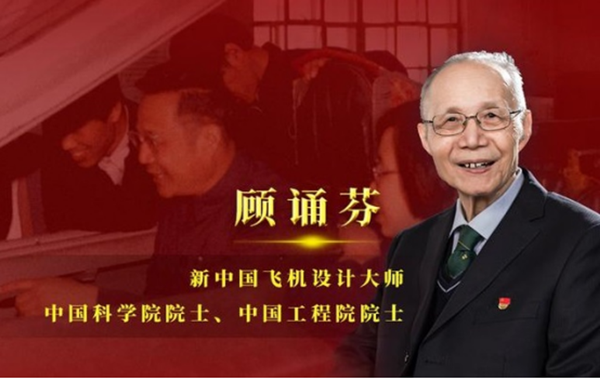Gu Songfen: A dedicated aircraft designer winning State Preeminent Science and Technology Award

Gu Songfen, an aircraft designer of New China, academician of both the Chinese Academy of Sciences and the Chinese Academy of Engineering, and winner of the 2020 State Preeminent Science and Technology Award [Photo/mmcs.org.cn]
Gu Songfen sat in the rear cabin of the SAC JJ-6. Just about 10 meters ahead of him was the J-8 testing fighter — China's first twin-engine, high-speed high-altitude interceptor. The two fighters flew closely at a constant speed, with everyone on the ground holding their breath in anxiety.
At that time, significant difficulties presented themselves in the development of the J-8 fighter, which experienced strong vibrations during flight tests. However, without the necessary ground equipment and means, it was impossible to determine the cause of the problems. As the chief designer, Gu volunteered to fly alongside the J-8 fighter jet for three consecutive days, observing the situation firsthand through a telescope.
"We didn't have a camera; therefore, the only option was to have someone observe it closely," Gu explained. "How to observe? They simply attach a red woolen string to the tail of the airplane, and I would watch where the string shook."
When he made this perilous decision, he disregarded any advice from colleagues, stating simply, "I dare not let Jiang Zefei find out."
This was because he had promised his wife Jiang that he would never fly in an airplane again in his lifetime.
Gu's scholarly family shaped his aspirations in troubled times
Known as the master of aircraft design in New China, Gu is the unique individual who holds the title of academician of both the Chinese Academy of Sciences and the Chinese Academy of Engineering in the national aviation industry. It would seem his connection with airplanes was predestined from a young age.
He entered the world on February 4, 1930, in Suzhou, with his father, Gu Tinglong, recognized as an esteemed master of Chinese culture, and his mother, Pan Chenggui, a learned woman herself.
The calm of Gu Songfen's early years was abruptly interrupted in 1937 with the outbreak of the July 7 Incident (also known as the Lugouqiao Incident). The skies above his homeland, which once were clear and blue, became shrouded by Japanese warplanes, with the land below suffering repeatedly from the deafening assault of bombs. "Boom, boom — the fire and smoke from the explosions seemed almost within reach, and the glass windows were blown out by the shock waves......” This terrifying spectacle, which Gu Songfen witnessed at the tender age of 7, would remain etched in his memory for the rest of his days.
He harbored a conviction, thinking, “If our nation lacks airplanes, we’re destined to be oppressed in the future.” Thus, in his heart, Gu Songfen set a towering ambition: to build aircraft one day.
Being the youngest son, Gu Songfen was deeply cherished by his family. Observing his fascination with airplanes, his father, Gu Tinglong, spared no expense to acquire a sizable model airplane boasting a wingspan of one meter. This model rapidly became Gu Songfen’s prized possession; he would joyously launch it into the sky on clear days and, in adverse weather, amusingly navigate flights within the confines of their home. His father further fostered this passion by obtaining a series of Soviet texts on model airplane construction from a bookstore and by accompanying young Gu Songfen on visits to factories to witness the industrial process of manufacturing. Through such devoted patronage, Gu Songfen gained the skills necessary to craft his own aircraft models during his youth.
"My father was incredibly liberal-minded and refrained from meddling in my pursuits. He simply admonished me to approach whatever I do with earnestness," Gu Songfen reflected.
Yet, the legacy bequeathed by his father extended far beyond personal hobbies. In an era riven by conflict, as Japanese invaders pillaged without check and precious cultural relics and tomes of the Yangtze's southern shores suffered great losses, Gu Tinglong boldly uprooted his family to the south. Assuming the director-generalship of the Shanghai Private Hezhong Library, he committed himself to the safeguarding of historical records.
This deep-seated patriotism profoundly shaped the course of Gu Songfen's life.
Hard times sharpened Gu's lofty aims
Gu Songfen's first involvement in aircraft design was with the Shenyang JJ-1, the first subsonic jet trainer to be independently developed by China.
During the 1950s, Soviet specialists arrived in China to assist with aircraft development but kept their design technology a closely guarded secret.
"Every time I placed an order with the Soviet side, I would fill in the requirements for a 'Designer's Guide' and 'Strength Specification' among others, but I never got a reply," Gu Songfen reflected. "If we could only imitate and not design aircraft ourselves, it meant having our lives in someone else's hands. I have a very deep understanding of this."
In 1956, New China's first aircraft design office was established in Shenyang. The facilities were exceedingly simple, with a laboratory converted from a toilet, yet the team was fueled by enthusiasm.
At the young age of 26, Gu Songfen was appointed head of the pneumatic group for the Shenyang JJ-1 jet trainer. Having studied only the basics of propeller aircraft design in college, he had to start learning much from scratch. Notably, Xu Shunshou, the design office director, suggested a novel idea: "design the air intake on both sides instead of in the nose" — a concept that was unprecedented in China.
Gu Songfen had to rely on the Beihang University library to search for materials and manually trace useful diagrams. Overcoming numerous obstacles, Gu Songfen and his design team managed to launch the Shenyang JJ-1 into the sky by July 1958 — taking just one year and nine months from the drawing board to the first flight, which was exceptionally swift even by international standards.
The development of the J-8 jet fighter began in 1964. Tragedy struck soon after chief designer Huang Zhiqian died in a plane crash while on an overseas mission. Gu Songfen, along with other key team members, was charged with forming a technical office and taking over the project.
Huang had been Gu Songfen's superior, mentor and comrade, alongside whom he had worked for many years. Furthermore, it was Huang who introduced Gu to his future wife, Jiang Zefei, Huang's sister-in-law. Consequently, Huang's untimely passing deeply affected Gu Songfen and his wife. As a result, Jiang forbade Gu Songfen from flying again.
This mandate explained why, on the days when Gu Songfen personally took a fighter jet to investigate the J-8's vibration issues, he refrained from consuming the meals prepared for test pilots, choosing instead to eat at home to avoid causing his wife any worry.
On December 31, 1979, at 10 pm, on New Year's Eve, the J-8 was officially finalized. They celebrated with a meal opposite the canteen on the second floor. Gu Songfen, who typically refrained from drinking, became intoxicated that night.
"We stumbled through the development of the J-8," Gu would later say.
In 1985, the J-8 fighter received the special prize of the National Science and Technology Progress Award.
However, this was merely the commencement of Gu Songfen's arduous journey in aircraft development. The path ahead held not just the blue sky but the infinite cosmos.
Though in old age, Gu drives the development of the aviation industry
In 1986, Gu Songfen was transferred to Beijing as the deputy director of the Science and Technology Commission of the Aviation Industry of China, and he became involved with China's manned space program.
In the 1990s, Gu Songfen initiated and organized cooperation with Russian aerodynamics and aircraft design experts on the design of far-sighted aircraft — a move that trained more than 250 core aircraft designers in China and laid the groundwork for the design of a new generation of fighters.
In 1995, Gu Songfen led a technical team in the development of China's first ground-effect vehicle.
Since 2000, Gu Songfen has demonstrated the foresight of a strategic scientist, making significant contributions to the advancement of large aircraft (including both large passenger and large military transport aircraft), aviation science and technology, and its associated equipment. He has also been a leading advocate for China's domestic large aircraft project.
As the saying goes, "An old steed in the stable still aspires to gallop a thousand li." However, Gu Songfen can be likened to a roc — an enormous legendary bird that evolved from the gigantic fish, kun — soaring high and elevating China's aspirations in the aviation industry.








